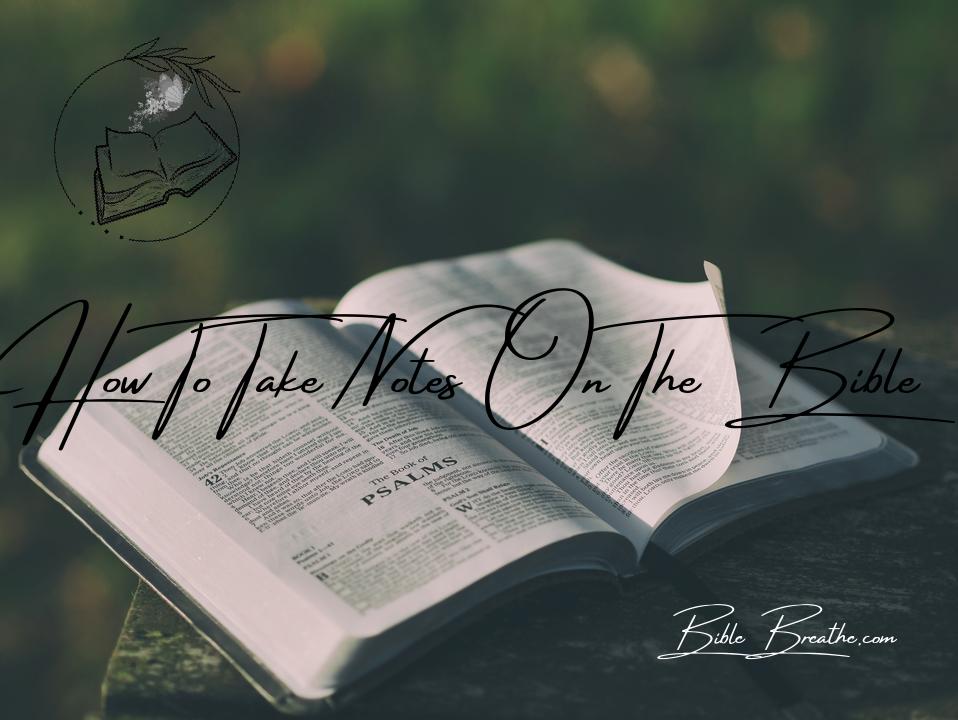How to Take Notes on the Bible?
It’s like having your Bible as a trusty GPS on the road of life, but your notes?
They’re the pictures, the highlights, and the bookmarks along the way, making your journey with the Lord more vivid and meaningful.
Now, you might be thinking, “Why should I take notes while diving into the Word?” Well, let me tell you, it’s not just about reading; it’s about truly understanding and retaining those divine messages.
It’s like sowing seeds in a well-tended garden, and your notes are the markers for each precious seed.
With organized notes, you’re not just scratching the surface; you’re digging deep into verse analysis, character exploration, and chapter summaries, unlocking the treasures within.
Imagine it as color-coding your thoughts and creative note-taking techniques that light up your spiritual path.
So, join me on this adventure, where we explore the art of Bible note-taking and how it can elevate your spiritual journey.
Let’s dive into the Word together and make it come alive like never before!
📖🌟
Key Takeaways
- Transformative Power of Active Bible Study: Taking notes on the Bible is an active form of engagement that can lead to a deeper understanding of scripture and a more profound spiritual experience. It allows you to interact with the text, ask questions, and make connections that may not be immediately evident.
- Blend of Creativity and Structure: Effective note-taking on the Bible often involves a blend of creativity and structure. While structured notes can help you organize information and key insights, creative elements like illustrations, diagrams, or personal reflections can make your notes more engaging and memorable.
- Revisiting and Reflecting: Notes taken during Bible study are most valuable when revisited and reflected upon. Regularly reviewing your notes allows you to reinforce your understanding, track your spiritual growth, and apply the lessons learned in your daily life.
- Recording Insights and Questions: When taking notes, record insights that resonate with you and questions that arise from your reading. This not only helps you remember key points but also provides a starting point for further exploration and discussion.
- Prayerful Approach: Consider incorporating a prayerful approach into your note-taking. Write down your prayers, thoughts, and feelings as you read the Bible. This can deepen your connection with God and enhance your spiritual experience.
- Use of Technology: In today’s digital age, consider using technology for note-taking. There are various apps and software designed for Bible study that allow you to highlight, make annotations, and organize your notes electronically.
In summary, taking notes on the Bible is a transformative practice that combines creativity and structure.
It helps you engage actively with scripture, reinforces your understanding, and fosters spiritual growth.
Regularly revisiting and reflecting on your notes can enhance your connection with God and deepen your knowledge of His Word.
Nourishing Your Soul with Bible Notes
Photo modified by BibleBreathe.com. Original photo by John-Mark Smith on Pexels
When it comes to studying the Bible, it’s not just about reading words; it’s about embarking on a profound journey into the heart of spiritual wisdom.
Taking notes during your study time is like whipping up a delicious meal from fresh ingredients – it elevates your understanding and enriches your experience.
Unveiling the Power of Bible Notes
Think of reading the Bible as a quest for hidden treasures, and your notes as the guideposts along the way.
They’re like the markings on an ancient map, showing you the paths to explore and revealing the secrets waiting to be uncovered.
Your Bible study notes are invaluable companions on this adventure.
They capture your thoughts, questions, and epiphanies as you navigate the intricate terrain of scripture.
“”Thy word is a lamp unto my feet, and a light unto my path.”” – Psalm 119:105 (KJV)
Going Beyond Reading: Engaging with the Bible
Merely reading the Bible is like glimpsing at a captivating painting from afar.
But immersing yourself in the scripture through note-taking is like stepping right into that painting, becoming part of its colors, textures, and stories.
Notes transform a one-sided conversation into a dynamic dialogue, allowing you to interact with the text, explore its depths, and extract personal and profound meaning.
With notes in hand, you’re not just an observer; you’re an active participant in the divine narrative woven within the pages of the Bible.
So, grab your favorite pens, highlighters, and a trusty notebook.
Let’s turn your Bible study into a lively, interactive journey of discovery and spiritual growth.
In the upcoming sections, we’ll delve into various techniques and tools to make your note-taking experience truly enriching.
Nurturing Your Bible Journey: A Guide to Effective Note-Taking
Photo modified by BibleBreathe.com. Original photo by Pixabay on Pexels
So, you’ve got the Good Book in your hands, ready to dive into its profound wisdom, seeking guidance and inspiration for your life’s journey.
But how do you capture and retain all the pearls of wisdom within those sacred pages?
How do you transform words written centuries ago into a roadmap for your modern-day living?
Embracing the Art of Bible Note-Taking
Taking notes on the Bible isn’t just about jotting down words on paper—it’s about embracing a journey, an exploration of your faith, and a connection with the divine.
It’s like painting a mural, each stroke telling a story.
“Thy word is a lamp unto my feet, and a light unto my path.” – Psalm 119:105 (KJV)
It’s as if you’re picking up a lantern in the darkness, lighting your path with the timeless wisdom of Scripture.
Addressing Common Misconceptions
Some may think taking notes during Bible study is tedious or unnecessary—after all, can’t you just read and understand?
However, the Bible is a vast, intricate tapestry.
Taking notes helps unravel its layers, making the complex comprehensible.
It’s like having a guide on a dense forest trail.
Imagine you’re navigating through a dense forest, and with each note you take, you’re forging a clearer path to the heart of God’s message.
Tips for an Enjoyable and Creative Note-Taking Experience
- Color Your Understanding: Just as nature uses a multitude of colors to express its beauty, use colors to highlight themes, emotions, or key messages in your Bible. Imagine each color as a brushstroke on the canvas of your understanding.
It’s like adding vibrant hues to a black-and-white painting, bringing out the depth and beauty of God’s Word.
- Verse Analysis for Deeper Insights: Break down verses into phrases or KEYWORDs. It’s like dissecting a complex piece of machinery to understand how it works.
Picture yourself as an engineer, carefully examining the intricate components of God’s truth, discovering how they fit together.
- Character Exploration: Dive into the characters of the Bible, understanding their strengths, weaknesses, and how their stories relate to your own life. It’s like learning from the experiences of friends.
Think of the Bible’s characters as your mentors, guiding you through the ups and downs of your spiritual journey.
- Chapter Summaries for a Bird’s Eye View: After reading a chapter, summarize its essence in a few sentences. It’s like standing on a hill and taking in the vast landscape before you.
You’re not just seeing individual trees; you’re experiencing the beauty of the entire forest.
- Sermon Insights: When listening to a sermon, jot down your thoughts and reflections. It’s like capturing the whispers of wisdom from a cherished mentor.
Imagine you’re having a heart-to-heart conversation with a trusted friend, soaking in their valuable insights.
So, embrace the colors, the analysis, and the explorations.
Let your Bible become a canvas where your understanding of faith, life, and purpose is painted.
And remember, just as an artist grows with each stroke of the brush, you grow with each note you take in your spiritual journey.
Penning Love Letters to the Divine: The Art of Bible Note-Taking
Photo modified by BibleBreathe.com. Original photo by Anna Tarazevich on Pexels
In the realm of faith, taking notes during your Bible study is akin to composing a personal love letter to the divine—a way of whispering back to the Creator amidst the vast expanse of sacred words.
A Desire to Preserve: Scriptures and Sermons
Have you ever encountered a breathtaking view that stirred your soul, etching an indelible mark on your memory?
Much like capturing a captivating sunset in a photograph, we aspire to capture the essence of scriptures and sermons through our notes.
Bible study notes serve as our mental snapshots, preserving the brilliance of the teachings we encounter.
“”Thy word have I hid in mine heart, that I might not sin against thee.”” – Psalm 119:11 (KJV)
In the hustle and bustle of daily life, memories can fade, but notes act as gentle reminders, reigniting the flame of those moments spent in communion with the divine.
When we revisit our notes, the wisdom contained within them springs to life, guiding our steps and choices.
Drawing Nearer to the Lord: The Essence of Note-Taking
Picture yourself composing a heartfelt letter to a dear friend.
Your words carry intimacy, care, and a deep longing to know them better.
Similarly, our notes are our heartfelt letters to the Lord, our way of saying, “I’m listening, I’m learning, I’m growing in faith.”
The act of taking notes, whether it involves jotting down verses, contemplating scriptures, or recording personal insights, reflects our longing to draw closer to the Lord.
It’s an act of spiritual intimacy, a deliberate effort to inscribe His teachings on the tablet of our hearts.
“”Draw nigh to God, and he will draw nigh to you.”” – James 4:8 (KJV)
Through our notes, we weave a tapestry of our spiritual journey—a narrative of our exploration of faith.
Every line, every annotation, contributes to the portrait of our devotion and dedication.
It’s a tangible expression of our walk with the divine.
So, let’s continue this sacred journey of note-taking, delving deeper into ways to enrich our spiritual connection and understanding.
Nourishing Your Soul: The Power of Bible Note-Taking
Photo modified by BibleBreathe.com. Original photo by Karolina Grabowska on Pexels
In the symphony of faith, the Bible holds the sheet music, guiding our spiritual melody.
Yet, to play this beautiful composition with precision and passion, we need to take note of its intricate notes and rhythms.
Enhancing Attention and Focus
Imagine studying the Bible without note-taking is like trying to appreciate a starry night without pausing to gaze at each shimmering star.
Notes serve as your guide through the celestial expanse, focusing your attention on critical elements.
Be still, and know that I am God.” – Psalm 46:10 (KJV)
It’s as if you’re stargazing, each note a twinkle in the vast sky of God’s Word, guiding you to a deeper understanding.
Improving Memory Retention
Our minds are like sponges, absorbing the ocean of knowledge the Bible offers.
However, just as a sponge can only hold so much water, our minds can only retain so much information.
Notes act as the vessel, preventing the precious truths from slipping away like water through our fingers.
Imagine your mind as a treasure chest, and notes are the keys that keep the treasures safe and accessible for a lifetime.
Organizing Ideas and Understanding Context
Ever tried solving a complex puzzle without first sorting the pieces?
Note-taking is akin to sorting.
It helps organize the teachings, stories, and insights, making it easier to grasp the bigger picture—the context that breathes life into the words.
“For God is not the author of confusion, but of peace.” – 1 Corinthians 14:33 (KJV)
Think of it as assembling a jigsaw puzzle; each note is a piece that contributes to the beautiful whole.
The Symphony of Benefits
-
Verse Analysis: Breaking down verses and passages into smaller, digestible portions allows for in-depth analysis. It’s like savoring each bite of a delicious meal, discerning the flavors and ingredients.
-
Topical Study: Categorizing notes by topics helps to delve into specific themes or subjects, allowing you to navigate the vast ocean of the Bible with a compass.
-
Character Exploration: Tracking the lives and lessons of biblical characters enriches your understanding of human nature and faith. It’s like reading biographies that inspire and teach.
-
Color-Coding: Assigning colors to different aspects adds vibrancy to your notes, making it visually appealing and aiding quick recall. It’s like color-coding a roadmap for a journey.
In this grand script of life, note-taking is your director’s script—it guides your actions, emotions, and decisions.
Embrace it, let it be the lantern that lights your path through the sacred corridors of the Bible, illuminating the divine truths within.
Crafting Your Personal Bible Study Toolkit: Practical Note-Taking Ideas
Photo modified by BibleBreathe.com. Original photo by Ivan Samkov on Pexels
Engaging with the Bible isn’t just about reading—it’s about diving deep, exploring the profound landscapes of scripture, and shaping your spiritual understanding.
Taking notes is like having a toolkit, and each tool in it serves a specific purpose.
So, let’s open up this toolkit and see how you can tailor it for your unique journey.
Verse Studies: Uncovering the Gems
Imagine each verse as a precious gem, waiting to be discovered and polished to reveal its inner brilliance.
Verse studies are like the chisels and brushes that help unveil the beauty of each verse.
In your notes, structure it to include the verse itself, its context, the historical backdrop, and any cross-references.
Dive into the meanings of words, and ponder the spiritual truths it holds.
“”Thy word is very pure: therefore thy servant loveth it.”” – Psalm 119:140 (KJV)
Topical or Word Studies: Organizing Wisdom by Themes
Think of it like gathering beautiful seashells on the beach.
Topical studies are like sorting them into different categories—love, faith, patience—helping you organize the wisdom of the Bible around specific themes.
Create a dedicated section in your notes for each theme, jotting down relevant verses, insights, and your reflections.
Character Studies: Unveiling the Bible’s Stars
Characters in the Bible are like stars in the night sky—each one unique, with their own story and radiance.
Character studies involve taking detailed notes on individuals or groups, understanding their lives, struggles, and triumphs.
Include their qualities, actions, and the lessons we can glean from their experiences.
“”And what shall I more say? for the time would fail me to tell of Gedeon, and of Barak, and of Samson, and of Jephthae; of David also, and Samuel, and of the prophets:”” – Hebrews 11:32 (KJV)
Chapter Studies: Summarizing the Journey
Chapters in the Bible are like chapters in a captivating book, each contributing to the larger narrative.
Chapter studies involve summarizing the key points, themes, and events within a chapter.
It’s like taking a panoramic photograph, capturing the essence of a segment of scripture.
Sermon Notes: Capturing the Essence of Preachings
Just as a skilled artist paints a vivid picture with words, a preacher does the same with sermons.
Sermon notes allow you to capture these visual strokes, jotting down key points, quotes, and personal insights.
It’s like preserving the echoes of a sermon long after the sanctuary doors have closed.
In the tapestry of your faith journey, these notes become the vibrant threads that weave together understanding, devotion, and spiritual growth.
Let’s continue to explore these tools and refine your note-taking artistry.
Unleashing Creativity in Bible Note-Taking: A Vibrant Approach
Photo modified by BibleBreathe.com. Original photo by Anete Lusina on Pexels
In this grand tapestry of faith, your Bible can be a canvas, and your notes the strokes of color that bring it to life.
Creative note-taking is not just a task; it’s an art form.
Let’s splash some color, add some doodles, and make these ancient words feel alive.
Color-Coding: The Palette of Understanding
Imagine your Bible as a magnificent garden, and each verse a different bloom.
Color-coding is like assigning each flower a unique color.
It helps you navigate through the garden of verses, making it a joyful journey.
“Thy word is a lamp unto my feet, and a light unto my path.” – Psalm 119:105 (KJV)
Think of it as giving each verse its own vibrant hue, making the landscape of God’s Word come alive.
Images, Stickers, and Doodles: A Story in Pictures
Have you ever noticed how a picture can tell a whole story, sometimes even more vividly than words?
Incorporating images, stickers, and doodles into your notes is like adding illustrations to a book.
It’s a playful way to capture and remember essential concepts.
Imagine your notes as a picture book, where every image and doodle adds depth and color to the story of your faith.
Tip-Ins: Expanding the Canvas
Tip-ins are like opening a hidden compartment in a treasure chest.
They allow you to add extra space for notes, diagrams, or reflections, expanding your understanding and creativity.
Think of tip-ins as secret pockets of wisdom, ready to be explored whenever you need a little more insight.
Washi Tape: Weaving Structure and Beauty
Washi tape is like the borders and frames of a beautiful painting.
It adds structure and beauty to your notes.
Use it to divide sections, highlight verses, or simply to make your notes visually appealing.
“Let all things be done decently and in order.” – 1 Corinthians 14:40 (KJV)
Picture your notes as a work of art, with washi tape as the elegant frame that brings out the beauty of God’s Word.
A Symphony of Creativity
-
Bible Journaling: Treat your Bible like an art journal. Draw, paint, and express your thoughts creatively. It’s like composing your melody to the divine symphony.
-
Scripture Writing: Write verses in artistic fonts, emphasizing the words that resonate with you. It’s like accentuating the melody in a song.
-
Bible Study Tools: Incorporate tools like bookmarks, tabs, and sticky notes. They’re like tuning your instrument, making sure every note is perfect.
So, grab your brushes of creativity, your palette of colors, and start painting your understanding of the Bible.
Let your notes be a reflection of your faith journey—vibrant, expressive, and uniquely yours.
Frequently Asked Questions (FAQs) About How To Take Notes On The Bible
Why is note-taking important in Bible study?
Note-taking in Bible study is vital for recording insights, references, and personal reflections.
It helps in understanding, retention, and applying biblical teachings to one’s life.
It also facilitates future reference and sharing with others.
How can I make my Bible notes more engaging and creative?
To make your Bible notes engaging, use various techniques such as highlighting key passages, using different colors for themes, creating visual summaries, adding personal reflections, and asking questions.
Adding creative elements like illustrations or diagrams can also enhance your understanding and engagement with the text.
What are the best tools and resources for Bible note-taking?
Useful tools for Bible note-taking include study Bibles, apps like YouVersion or Olive Tree, journals, and software like Logos Bible Software.
Employing highlighters, colored pens, and sticky notes to mark important verses, key points, and personal insights can also aid in effective note-taking and deeper understanding.







